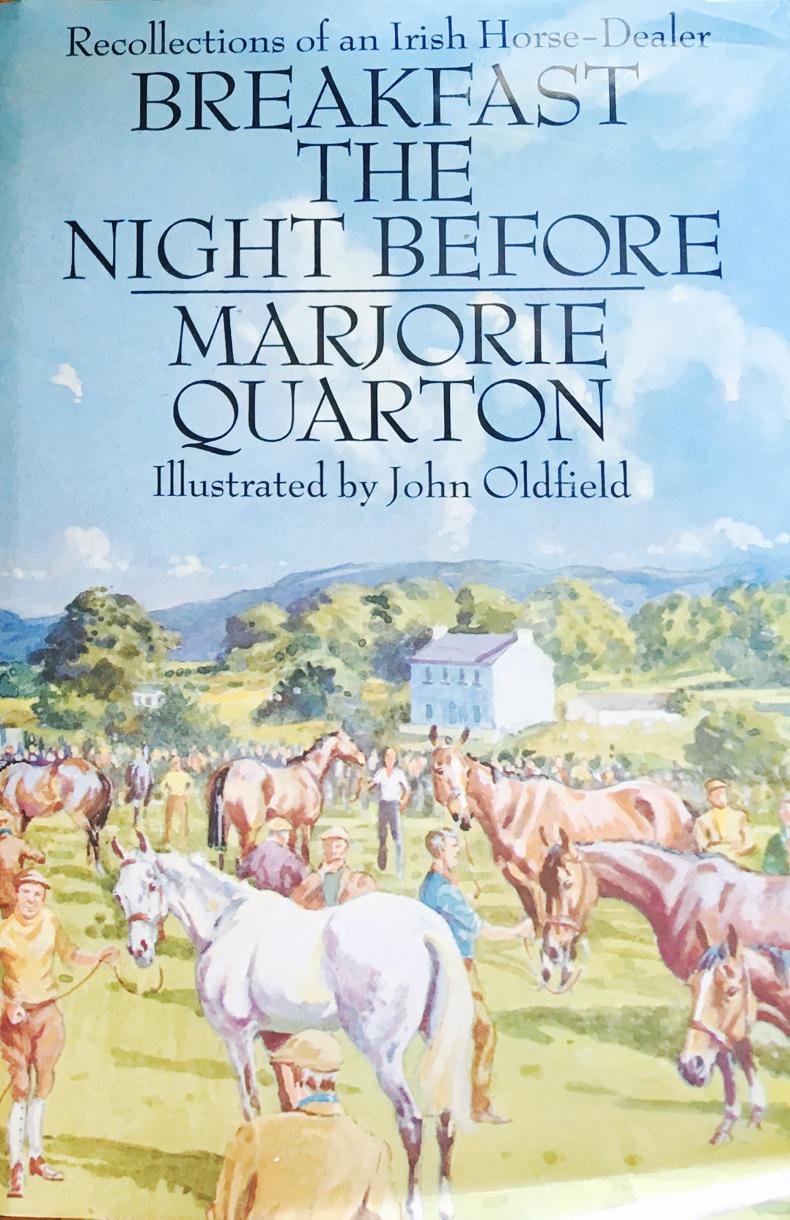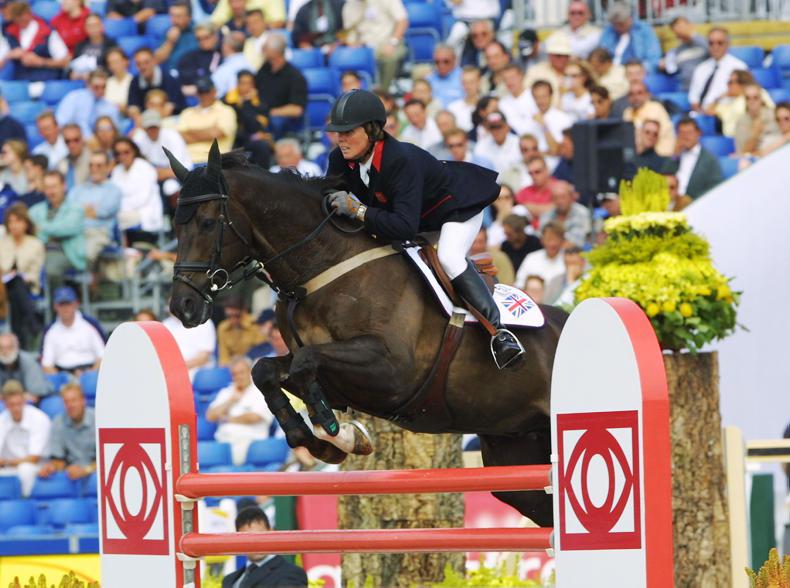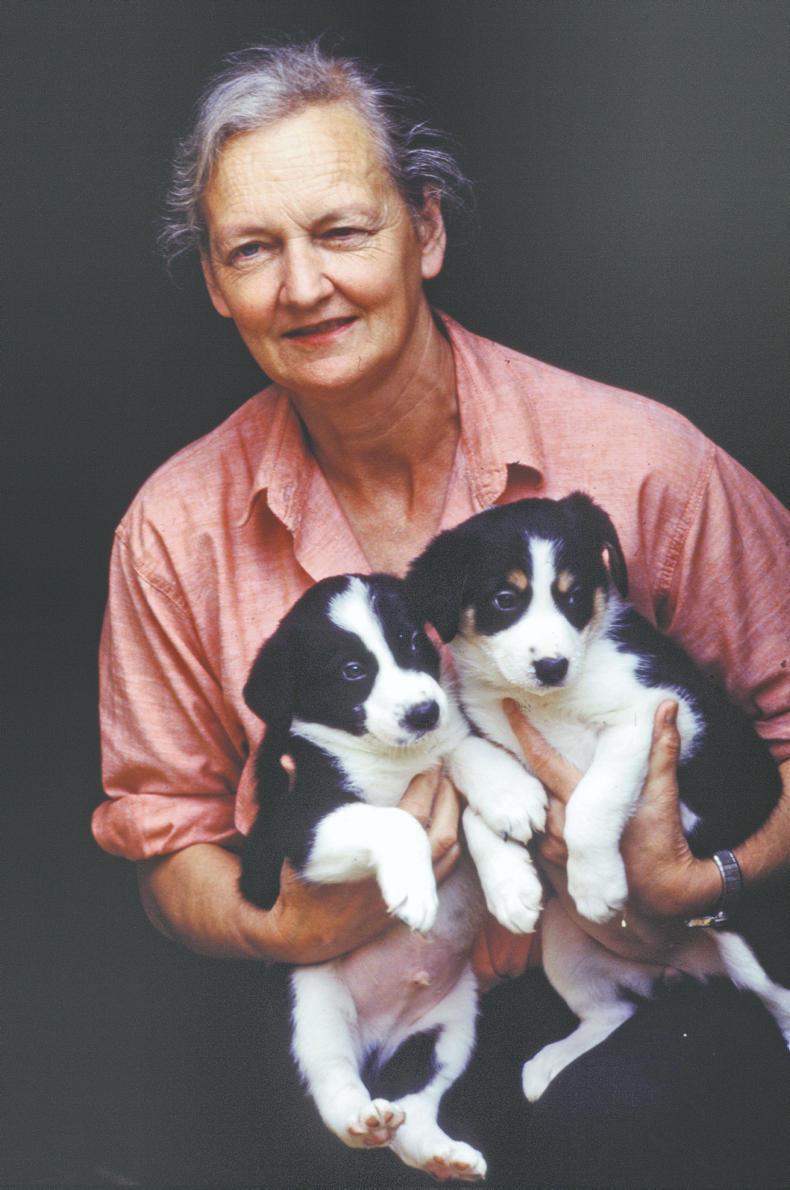SHE’S the well-known horse dealer who, with all credit to the postmen involved, once received a letter addressed to “The Horsewoman called Margerine who lives in Tipperary”. That was during the years when Marjorie Quarton was a familiar sight at horse fairs around the south and west of Ireland.
Not only does her remarkable life story include years of buying and selling on horses to the police forces and England’s leading dealers, but it later saw Marjorie carve out a successful career as an author.

‘Breakfast The Night Before. Recollections of an Irish horse dealer’ is a classic; a beautifully-written memoir on her upbringing in north Tipperary and decades of trawling fairs, once hacking her latest purchase home from Nenagh train station or in a single, two-wheeled trailer towed by her trusty Morris Minor.
Laced with humorous and insightful tales about characters, eccentrics and rogues, invaluable snippets on near-forgotten sires and recollections of her purchases, this gem is one to snap up online.
An only child, her father Major Standish Smethwick, was wounded during World War I and as she grew up, his health progressively worsened.
“Father was in the Royal Dublin Fusiliers and by the time I left school when I was 17, I knew I would have to run the farm.”
Not that academic life had appealed to Marjorie, who learned to read when she three. “I went to boarding school in Knockrabo, or the ‘hill of the cow’. It’s no longer there, the house was torn down but it was right opposite Mt Anville. I hated every minute of it!”
Her father’s deteriorating health had already meant that the 16-year-old Marjorie was dispatched by him with two blank cheques to buy 20 bullocks at a local fair, which earned her £2 commission and opened up the possibility of making a living from dealing.
However, it took a £100 legacy from her uncle Algy, handed over by her father in “crisp new tenners” to provide the necessary capital to start in earnest.
THE LUCK PENNY
The inheritance was spent by his grateful niece on two bullocks and a horse, duly christened Sally. A £2 luck penny was spent on a new bridle and after Sally was broken and hunted by Marjorie, she was sold through an advertisement in The Irish Field for £125 and later went on to be a Dublin prizewinner.
Profit that was quickly reinvested in the next set of purchases, including another horse, a pony, a bullock, breaking tackle and a gramophone. From then on, the young Tipperary dealer became self-sufficient.
Making a living from dealing for almost 35 years was a balancing act. “The trick was to keep selling on as quickly as possible,” although she often spent several months schooling a youngster or putting one out on grass if she felt it needed more time.
Patience was a factor in the story of the future Aachen Grand Prix winner Buttevant Boy. He was spotted at the now-defunct Limerick Fair by Marjorie, who pencilled him in as a possible recruit for the UK mounted police units, one of her best clients.
“He went home from the fair with the man that owned him.” However there was something about the “very quiet, brown horse” that made Marjorie drive down to Old Pallas on the Limerick-Tipperary border for a second look.
He was by the exotically-titled thoroughbred Chi Chi Castenango, a Guatemalan town named by Spanish conquistadors, who stood with John (Luke) Ryan in Cappamore and noted for producing good jumpers, many exported without a paper trail. However, his dam, who used to bring milk to the creamery, nearly put off the prospective buyer for a second time. “She was about 15 hands and rather a plain little mare,” noted Marjorie.
The deal was done and Marjorie let the legendary Yorkshire dealer Billy Bamlet know she had a horse for him to view.
“He wanted to wait until I had two as it was cheaper to transport two horses than one. He was also looking for a mare for Graham Fletcher as he had done so well with a mare nicknamed The Grasshopper. How he could sit on her I couldn’t imagine as she had the most unorthodox way of jumping!”
Bamlet, who bought horses for the Metropolitan Police, initially turned down Buttevant Boy as too small. “When I bought him, he wanted to be all the height he had,” said Marjorie, agreeing with his assessment, so she backed the good-natured youngster and turned him out to grass for the summer.
Marjorie’s wedding took place in October 1967, although the first meeting with her future husband John Quarton, when the Yorkshire widower arrived in the Smethwick’s yard, was an inauspicious one.
“A dealer had brought him to my place and I was sick in bed. The other dealer shouted up to my bedroom window “I’ve a man here, he’ll give you a good price for a horse!” but I told them to come back another day.”
HOUSEHOLD NAME
Bamlet also returned that autumn when Marjorie was keen to sell as many as she could before winter set in. “Billy came over to see this horse. I rode him down the avenue, probably bareback as I found it easier to get off a young horse when you don’t have a saddle to impede you and then we lunged him over a jump, about four foot high. He always tucked his feet up. I said ‘Thats all I’m doing with him’ to Billy as the horse was just off grass, but Billy took him home.”
The four-year-old Buttevant Boy was spotted by Graham Fletcher’s father Ken out hunting with the Bedale and he snapped him up for £180. By the following autumn, a 16-year-old Graham and four-year-old Buttevant Boy were the youngest combination in the Foxhunter final at Wembley, where they finished fourth and won the young riders final too.
By the time the horse retired at 18, his winnings added an extra 700 acres to Ken Fletcher’s farm. A veteran of seven Nations Cup, the pair also won the world’s toughest Grand Prix class at Aachen, plus a popular win on native ground in the 1971 Grand Prix at Dublin.
Unlike some of the ‘here today/gone tomorrow’ current stars, his long career and distinctive appearance made Buttevant Boy, like Ryans Son, an enduring household name character. The Horse of the Year Show, where ‘Butt’ and Fletcher claimed a stash of wins each year, had a primetime slot on BBC back then, adding to show jumping’s mainstream popularity.
Not that Marjorie was an avid gogglebox follower. “I never had a television until we got married in 1967 and someone gave us one as a present. I don’t watch television!”
She has however appeared on television several times and is a regular guest on radio shows to promote her latest book. “I was scared stiff!” she says, recalling her appearance on Kenny Live in 1989 when ‘Breakfast The Night Before’ was first published.
“I was doubly frightened as I was supposed to go on after a particularly talkative fellow, who then went on to sing all of ‘Phil the Fluters Ball’. He [Pat Kenny] was very charming though.”
END OF AN ERA
Her switch to a writing career and breeding border collies came about after the trooper and police horse trade dried up and as fairs started to disappear from the calendar. Supplying horses as cavalry remounts was the mainstay of many horse fairs in the 19th and 20th centuries, although both world wars exacted a high equine toll.
“They took the active Irish horse. The Irish Draught was ideal; unflappable and strong but killed in their hundreds of thousands. The half-bred horses were bought as chargers. After the war, the British were supposed to replace them and sent Shires and Clydesdales, mostly to the midlands, were they were used to pull turf.
“They also sent us some Arabians to replace the officers’ horses. We didn’t get in what we sent out but that wasn’t the fault of the British, as they didn’t have light draught breeds or enough thoroughbreds.
“Thoroughbreds do have a second job, and a third and a fourth, provided they’re straight movers and have good bone. They’ll find another job.” However, the disappearance of the trooper market left other horses unemployed.
“The Swiss trooper trade was great while it lasted. When they did their national service, each fellow was provided with a horse and when his service was over, he was given that horse to keep on his farm.
“After a time though, they started putting the recruits on motorbikes instead. You’d hope to sell half a dozen troopers to the likes of Dick Morgan or Nick Connors, then it got down to two and one pretty quickly. Dick would come to Crannagh, [the home farm] and I’d try to have about four to show him. They would buy anything up to 16 hands and had no objection to mares. The horse had to be a perfectly straight mover but the Swiss were very relaxed about vetting,” she said, describing the former market.
“Jack Powell, who was a matter of days older than my John, was our vet and he did examine a lot of horses for us. He and his wife Sheila were great friends of ours.”
Incidentally, another link to the opening story in this series was the sale by Marjorie of Brosna Queen to Suma Stud. Spotted at Ballinasloe Fair, she later sold the Rusheen Hero mare to Susie Lanigan-O’Keeffe and Marily Power and one of her later foals for her new owners proved to be the outcross stallion Glenagyle Rebel.
“OF ANOTHER AGE”
North Tipperary was a haven for stallions during that era. “Clover Hill had a lot of doubling up to do, he was used as the teaser in the beginning! Philip Heenan came out of another age, he wasn’t like anybody else. Downright to the point and honest, ‘I don’t like your mare, she’ll kick my fellow, now take her home’ he’d say,” remarked Marjorie, who recalled riding against Heenan in the North Tipperary point-to-point one year.
“I was on a mare named Sugar Bush. I bought her after she bolted and turned a hay rake over, throwing the farmer clear. She was one I kept for a long time. Her half-sister by a thoroughbred horse was winning point-to-points, so I took her hunting and ran her in the North Tipperary members race.”
Colliding with Heenan’s mount, the pair parted company at the water jump. “She arrived home a long time before I did but then I had to climb out of the Nenagh river and walk across a ploughed field, while several people asked if I’d fallen off!”
Sugar Bush was one of two purchases made in the same Irish visit by another famous dealer Tommy Grantham, the other being the legendary Stroller. “Sugar Bush started jumping in adult competitions and having won many important competitions became a member of the British jumping team, alongside Foxhunter and Nizefela. Both of these were very big horses and made Sugar Bush look like a very big pony.”
Marjorie’s mare was later sold on to Jabeena Maslin where she often jumped against her main rival Stroller. Sugar Bush was eventually sold into Switzerland for a reputed £9,000.

There is also another link to the Heenan era in the pedigree of Abbervail Dream, bred by Marjorie. “He was by Chair Lift, who stood with Col. Tony Dene down on the lake near Dromineer and then he went to Gort. I’d bought the mare in foal to Smooth Stepper [owned by Heenan] and she had rather a long back, I wasn’t mad about her.”
Another prospective covering plan for Abbervail Dream’s dam Killea Beauty went astray when Marjorie wrote to the late Jim O’Meara to enquire about a free return to his horse Donnolly’s Hollow. “And I received a sad reply that there may not be many more foals by him as the horse had been gelded in the meantime!”
Sold as a foal, Abbervail Dream was a veteran of 40 Nations Cups with Di Lampard and competed in two European Championships and two World Equestrian Games before his retirement in 2004. “Both Buttevant Boy and Abbervail Dream qualified for the Olympic Games but in both cases, their owners preferred for their horses not to compete.”
REINVENTION
Marjorie (88) herself retired from farming at the age of 70 and now lives in Nenagh, where her daughter Diana Fahey owns the successful interior design business Treetop Interiors.
Not that Marjorie has stopped working, as she is as busy as ever and in constant demand as an editor. Before that there was a stint handling the PR side of the National Council for the Blind in Ireland (NCBI).
“I worked for them for a lot of years, helping to open shops. Now there’s just short of 100 NCBI shops around the country. It took me weeks to go around them! I stayed working for them until I was 84 or 85.”
And before that, she was a noted breeder of border collies which led to a string of articles and books on the canine subject. “At the time I got married, dogs were beginning to take over, then there was the advent of a baby and then I started writing.

“I wrote about different things, including odd pieces for Val (Lamb) The (Irish) Field’s thoroughbred editor, for example when a race meeting had been rained off and he’d throw something at me at short notice; ‘Come up with something for Grand National day, I have room for 150 words’, so I said I could write about the very first National.
“I took it to the train in Nenagh that evening and gave it to the guard, that was the only way at the time to get copy in on the same day. Kevin Myers had to come on a bike from the office on D’Olier Street to collect it at Heuston Station, which he didn’t find very amusing!”
Telex, fax and email gradually replaced each other as a means of sending in copy as Marjorie continued her newfound career. “I wrote on and off for 10 years for The Irish Field, I also really enjoyed writing the Irish Farmers Journal series ‘With Dog and Stick’, that came about after a conversation with the lovely Quentin Doran-O’Reilly. I wrote several pieces for the Farming Independent too.”
And then there are her 15 books, some of which have been translated into various languages by the Readers Digest. “Corporal Jack was read twice on the BBC and is set in the First World War,” recalls Marjorie, proving true the old adage to write about what you know best.
Writing about her years buying at horse fairs was a natural step but how did she match up ‘Breakfast The Night Before’ with its ingenious title?
It’s origin was a Banner County fair that took place last weekend. “I was going to Spancilhill and I’d never been there before. It starts early so I asked someone in Ennis what time I’d have to start off at and he said ‘You’ll have to have your breakfast the night before!’ Spancilhilll was never that lucky for me though.
“It didn’t take long to write that book because I had a deadline and I wrote it very quickly,” added Marjorie, who used her diaries and records of hundreds of horses bought at fairs for inspiration. Plus the characters, such as the loyal Fairo, the Clareman who was her unofficial minder at the various fairs. “It was quite territorial, the whole dealing scene but I didn’t take too much notice because they fought with each other!”
Her writing skills have also brought her abroad. “I’m often asked if I’d like to have travelled more. I would have like to have travelled at the time, not now. I did go to Sicily for a writing course which was an extraordinary experience.
“I’d written at the time six or seven books so the title of the Readers Digest course I was to give on any subject I liked was Incursions on the English language.
“ I was put up in a beautiful double room with everything from Lucozade to champagne provided and at the end I had to buy another suitcase to hold the presents from the people on the course.
“I only started editing on a serious level six or seven years ago. I’m lucky because I was taught to edit by Diana Atthill, a wonderful teacher and lovely person, who celebrated her 100th birthday last Christmas. Now I do about five books a year. I like to be busy,” says this gentle, soft-spoken lady.
The Premier County recognised Marjorie’s multiple achievements when she received an Iconic Citizen of Tipperary award in 2015.
From her horse fair dealing years to reinventing herself as a successful writer, the mould was broken after Marjorie Quarton.


 This is a subscriber-only article
This is a subscriber-only article
 It looks like you're browsing in private mode
It looks like you're browsing in private mode








SHARING OPTIONS: